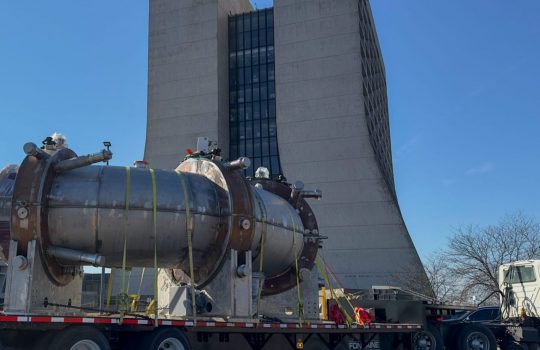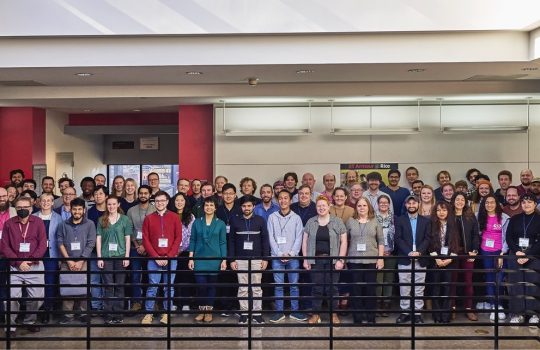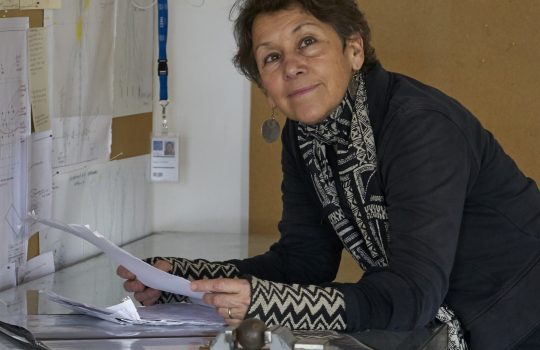Note: A shortened version of this release was issued earlier today by the U.S. Department of Energy.
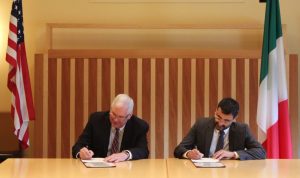
Jim Siegrist, associate director of the DOE Office of High Energy Physics, and Andrea Cascone, first counselor of the Embassy of Italy in the United States, sign the cooperative agreement for contributions to Fermilab’s Short-Baseline Neutrino program.
Yesterday, the U.S. Department of Energy and the Italian Embassy, on behalf of the Italian Ministry of Education, Universities and Research, signed an agreement for collaboration on research with the international Short-Baseline Neutrino (SBN) program hosted at DOE’s Fermi National Accelerator Laboratory.
The SBN program, started in 2015, comprises the development, installation and operation of three neutrino detectors spread over a distance of 600 meters on the Fermilab site. Italy and its National Institute of Nuclear Physics (INFN) are making major contributions to the SBN program, including the delivery and installation of one of the three detectors. Scientists will use the detectors and a neutrino beam from Fermilab’s particle accelerator complex to measure the properties of neutrino particles with unprecedented precision and search for a new type of particle known as a sterile neutrino.
“Italy is a strong partner of Fermilab and the department in advancing scientific research,” said Secretary of Energy Rick Perry. “Their expertise in the state-of-the-art technologies, essential to the SBN program and the international Deep Underground Neutrino Experiment, makes them a key partner in the global effort to solve the mysterious behavior of neutrinos.”
Previous experiments at DOE’s Los Alamos National Laboratory and at Fermilab have found evidence for neutrino interactions that scientists can’t explain within the best theory they currently have for the properties and interactions of the universe’s building blocks. Instead, the explanation could be the existence of a new type of neutrino with properties different from the three known types (electron, muon and tau neutrinos) or some other unknown phenomenon.
The SBN program comprises three neutrino detectors to be installed along one of Fermilab’s neutrino beamlines, known as the Booster Neutrino Beamline:
- The Short Baseline Near Detector, located 110 meters from the neutrino beam source: This detector will provide a measurement of the initial composition of the neutrino beam, which at this distance is expected to comprise almost exclusively muon neutrinos.
- The MicroBooNE detector, located 470 meters from the neutrino source: This detector, about the size of a school bus, will look for the first sign of the transformation of muon neutrinos into electron neutrinos.
- The ICARUS detector, located 600 meters from the neutrino source: Provided by INFN and first operated at the Gran Sasso Laboratory in Italy from 2010-2014, the ICARUS detector is the largest of the three detectors of the SBN program. It was refurbished at the European research center CERN before being shipped to Fermilab in 2017.
“After a long and productive scientific life at Gran Sasso National Laboratory, the ICARUS detector, refurbished at CERN, is starting a new adventure at Fermilab, a U.S. DOE laboratory where there is a long tradition of collaboration with INFN physicists,” said Fernando Ferroni, president of INFN. “The ICARUS detector, under the leadership of Nobel laureate Carlo Rubbia, will help to clarify the issue of the possible existence of sterile neutrinos. If discovered, they will be a revolution for the field.”
Once all the detectors have been installed in the Booster Neutrino Beamline, scientists will record data to solve the sterile neutrino puzzle. Using different distances from the neutrino source but the same liquid-argon technology, the three neutrino detectors will be able to distinguish whether their measurements are due to transformations between neutrino types involving a sterile neutrino or are due to other, previously unknown interactions.
“Together with the expertise of neutrino physicists from around the world, the three detectors of the SBN program will resolve the anomalies observed in previous experiments,” said Fermilab Director Nigel Lockyer. “This program will provide the best measurements for understanding these neutrino interactions.”
The signing of the SBN program collaboration agreement is an addendum to the umbrella agreement on neutrino physics research that the United States and Italy signed on July 17, 2015.
“The liquid-argon TPC technology was first introduced by the ICARUS team at INFN in Pavia over 20 years ago,” said INFN’s Carlo Rubbia, spokesperson for the ICARUS collaboration and a Nobel laureate. “The first physics experiment with 700 tons of ultrapure liquid argon was completed by ICARUS at the Gran Sasso Laboratory. Now at Fermilab, ICARUS will be the largest of three detectors to search with unprecedented accuracy neutrino events beyond the standard theory. This represents an important step forward in searching for new phenomena.”
Rubbia continued, “It is exciting to see that the same technology will be further developed by the huge 40-kiloton Deep Underground Neutrino Experiment detector, with the participation of more than 1,000 scientists worldwide.”
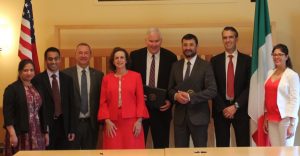
Gathered at the Italian embassy for the signing were, from left: Hema Ramamoorthi, Chief of Staff, Fermilab; Abid Patwa, Program Manager, Office of High Energy Physics, DOE; Nigel Lockyer, Director of Fermilab, Kathy Turner, Program Manager, Office of High Energy Physics, DOE; Jim Siegrist, Associate Director office of High Energy, Physics, DOE and Andrea Cascone, First Counsellor, Embassy of Italy in the United States of America; Stefano Lami Moscheni, Science Counselor, Embassy of Italy; Claudette M. Rosado-Reyes, AAAS Science and Technology Policy Fellow, Office of Science-International Programs, DOE
About 250 scientists from more than 50 institutions in Brazil, Italy, Switzerland, Turkey, the United Kingdom and the United States work on the international Short-Baseline Neutrino program at Fermilab. Funding is provided by CERN, the United States (DOE Office of Science and National Science Foundation), Italy (INFN), United Kingdom (STFC), Switzerland (NSF) and Brazil (FAPESP).
To learn more about the Short-Baseline Neutrino program at Fermilab, visit sbn.fnal.gov.
Fermilab is America’s premier national laboratory for particle physics and accelerator research. A U.S. Department of Energy Office of Science laboratory, Fermilab is located near Chicago, Illinois, and operated under contract by the Fermi Research Alliance LLC, a joint partnership between the University of Chicago and the Universities Research Association, Inc. Visit Fermilab’s website at www.fnal.gov and follow us on Twitter at @Fermilab.
The DOE Office of Science is the single largest supporter of basic research in the physical sciences in the United States and is working to address some of the most pressing challenges of our time. For more information, please visit science.energy.gov.
INFN, Istituto Nazionale di Fisica Nucleare, is the public Italian research institute dedicated to the study of the fundamental constituents of matter and their interactions. INFN conducts theoretical and experimental research in the fields of subnuclear, nuclear and astroparticle physics. Fundamental research in these areas requires the use of cutting-edge technology and instruments, developed by the INFN at its own laboratories and in collaboration with industries. All of the INFN’s research activities are conducted in close collaboration with Italian universities and undertaken within an international framework.

